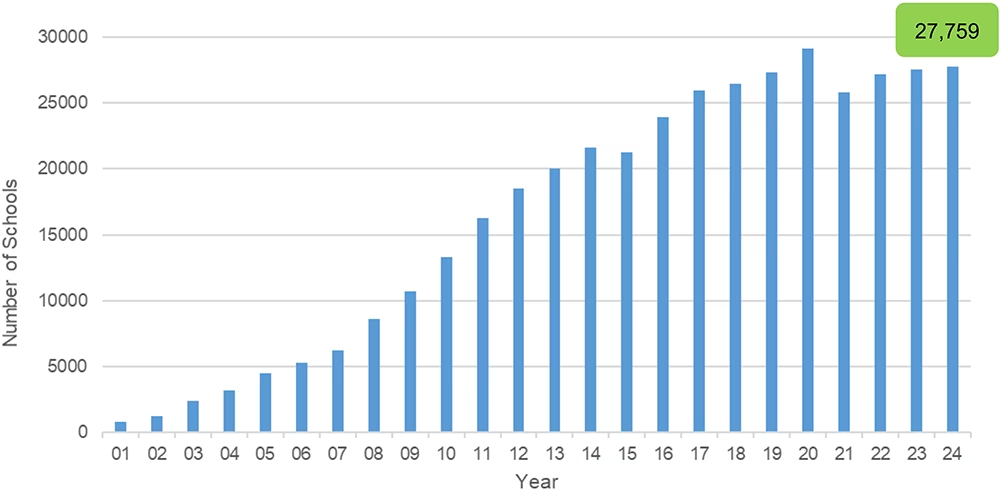Positive Behavioral Interventions and Supports (PBIS) is an evidence-based, tiered framework for supporting students’ behavioral, academic, social, emotional, and mental health. When implemented with fidelity, PBIS improves social emotional competence, academic success, and school climate. It also improves teacher health and wellbeing. It is a way to create positive, predictable, equitable and safe learning environments where everyone thrives. We use ‘students’ to refer to all children and youth in any educational or therapeutic setting (e.g., K-12 school, early childhood program, treatment program, juvenile justice program). Learn more about PBIS in schools, classrooms, early childhood programs and juvenile justice programs on those topic pages.

Schools implementing PBIS:
PBIS is not a curriculum you purchase or something you learn during a one-day professional development training. It is an ongoing commitment to supporting students, educators, and families through systems change. When you implement PBIS well, students experience improved behavioral, social, emotional, and academic outcomes; schools and programs reduce their use of exclusionary discipline practices and improve their overall climate.
Check out how schools across the country have implemented PBIS where they are.
PBIS emphasizes five inter-related elements: systems, data, practices, outcomes, and equity.

Your foundational systems establish the way your schools and programs operate. Systems include teaming structures, training, coaching, and other supports for educators. In PBIS, these systems support accurate, durable implementation of practices and the effective use of data to achieve better outcomes.
As you think about the systems supporting your PBIS framework, ask yourself:
What can we do to sustain our implementation over the long haul?
Your school or program generates a wide range of data about your students every day. Within the PBIS framework, teams use data to select, monitor, and evaluate outcomes, practices, and systems across all three tiers.
As you think about the data available to you, ask yourself:
What information do we need to make effective decisions about our PBIS implementation and outcomes?
The school and classroom practices you implement are critical to supporting students and creating a positive school climate. In PBIS, these interventions and strategies are backed by research and target the outcomes you and your community want to achieve.
As you think about the evidence-based practices you implement, ask yourself:
How will we support our students’ behavioral, social, emotional, and academic growth?
The ultimate goal of implementing PBIS data, systems, and practices is to improve outcomes. Families, students, and educators set goals and work together to achieve them. In PBIS, outcomes might include behavioral, social, emotional, and academic growth; positive school climate; or fewer office discipline referrals.
As you think about the outcomes you want to achieve, ask yourself:
What is important to each of our communities?
When you implement PBIS with fidelity, it fits seamlessly within your local context, regardless of the type of school. To do that requires a focus on connectedness and belonging. Leadership teams work with members of the school or program community — students, families, and community members — to prioritize valued outcomes and promote high expectations for all students. Centering equity also means supporting educators’ roles in implementation, adapting practices to meet students’ individual needs, and disaggregating data by student group to ensure success for everyone.
As you think about equity in your PBIS implementation, ask yourself: How can we enhance the experiences and outcomes of each educator and student?
Educators and practitioners provide a continuum of academic, behavioral, social, and emotional support matched to students’ needs. We describe this continuum across three tiers of support.

Foundational systems across all three tiers include:
Tier 1 systems, data, and practices support everyone – students, educators, and staff – across all school settings. They establish a foundation for positive and proactive support. Tier 1 support is robust, differentiated, and enables most (80% or more) students to experience success. Tier 1 practices include:
In addition to your Tier 1 foundation, students receiving Tier 2 supports get an added layer of systems, data, and practices targeting their specific needs. On average, about 10-15% of your students will need some type of Tier 2 support. The support you provide at Tier 2 is more focused than at Tier 1 and less intensive than at Tier 3. Tier 2 practices include:
At most schools and programs, there are a small number (1-5%) of students for whom Tier 1 and Tier 2 supports have not been sufficient to experience success. At Tier 3, students receive more intensive, individualized support to improve their outcomes. Tier 3 supports are available to any student with intensive need, whether they receive special education services or not. Tier 3 practices include: